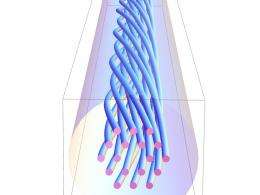Twisted photonic crystal fibres suppress specific optical wavelengths

(Phys.org) -- A simple longitudinal twist converts certain microstructured optical fibres into filters. Researchers at the Max Planck Institute for the Science of Light in Erlangen have measured this effect in detail in photonic crystal fibres and found a theory to explain it. The results of their research will allow new applications in optical communications and the construction of lasers, sensors and light amplifiers.
Glass fibres are used generally to transport light over long distances – for example, fast data transmission over the internet. Photonic crystal fibres (PCF) are a novel variant of such optical fibres, currently used mainly in basic research. Their cross-section is reminiscent of a honeycomb: tiny hollow tubes surrounding the core run along the circular fibre. They ensure that the light only travels in the core where it is transported with low loss.
The transmission behaviour of photonic crystal fibres changes significantly if they are twisted around their longitudinal axis – the transmission of certain wavelengths becomes much poorer. The optical fibre becomes spiral and works like a filter. The behaviour can be controlled very easily through the twist: with a stronger twist, the dips in transmission shift towards longer wavelengths.
The team of researchers working in Erlangen led by Philip Russell has studied this effect in detail. They secured one end of a PCF and used a motor to rotate the other accurately around its axis while scanning a carbon dioxide laser along to fibre to heat and soften the glass. Light from a supercontinuum source, able to emit light almost equally over a wide range of wavelengths, was then launched into the twisted fibre core and an optical spectrum analyser used to measure the transmission spectrum, i.e., to find out which wavelengths are suppressed particularly effectively.
In the experiment, the transmission in the wavelength range from 400 to 1000 nanometres dipped clearly at four points which, as expected, shifted towards longer wavelength when the PCF was more tightly twisted. The scientists also found very good agreement with their simulations: "Earlier studies explained the filter with a kind of lattice effect," said Philip Russell. "However, the wavelengths of the transmission minima would have had to increase with the length of the twist cycle. Our measurements and simulations show that exactly the opposite must be the case."
Russell explains the filter effect with an analogy from the 19th century: in 1878, the English physicist John William Strutt (Lord Rayleigh) noticed that sound was guided in a circular path around the dome of St. Paul's Cathedral in London. This "Whispering Gallery" effect also exists in optics, for example when light bounces around inside a glass microsphere many times, forming a high quality resonance at certain optical wavelengths.
Something similar happens to the wavelengths that are filtered out in the twisted photonic crystal fibres: orbital resonances appear in the honeycomb cladding, causing power to drain away laterally from the core instead of flowing straight ahead, so that only very little of it arrives at the other end. "With a sensitive camera, it would be possible to see the side of the fibres glowing in the colours which are particularly strongly suppressed," explains Russell.
The scientist anticipates interesting technical applications for the effect: "What is particularly attractive about it is that we can twist the PCFs almost any way we want after they have been made. That means, for example, that we have a lot of flexibility in making filters for specific wavelengths." These components play an important role in many areas: for optical data transfer as well as for sensors, fibre lasers and optical amplifiers. It is also possible to vary the twist along the fibres, which allows many different filters to be created. And finally, this makes it possible to modify the linear and non-linear responses of the fibres and thus influence two important parameters for generating a supercontinuum.
More information: Excitation of Orbital Angular Momentum Resonances in Helically Twisted Photonic Crystal Fiber, G. K. L. Wong, M. S. Kang, H. W. Lee, F. Biancalana, C. Conti, T. Weiss, P. St. J. Russell, Science, 27 July 2012: Vol. 337 no. 6093 pp. 446-449, DOI: 10.1126/science.1223824
Journal information: Science
Provided by Max Planck Society

















